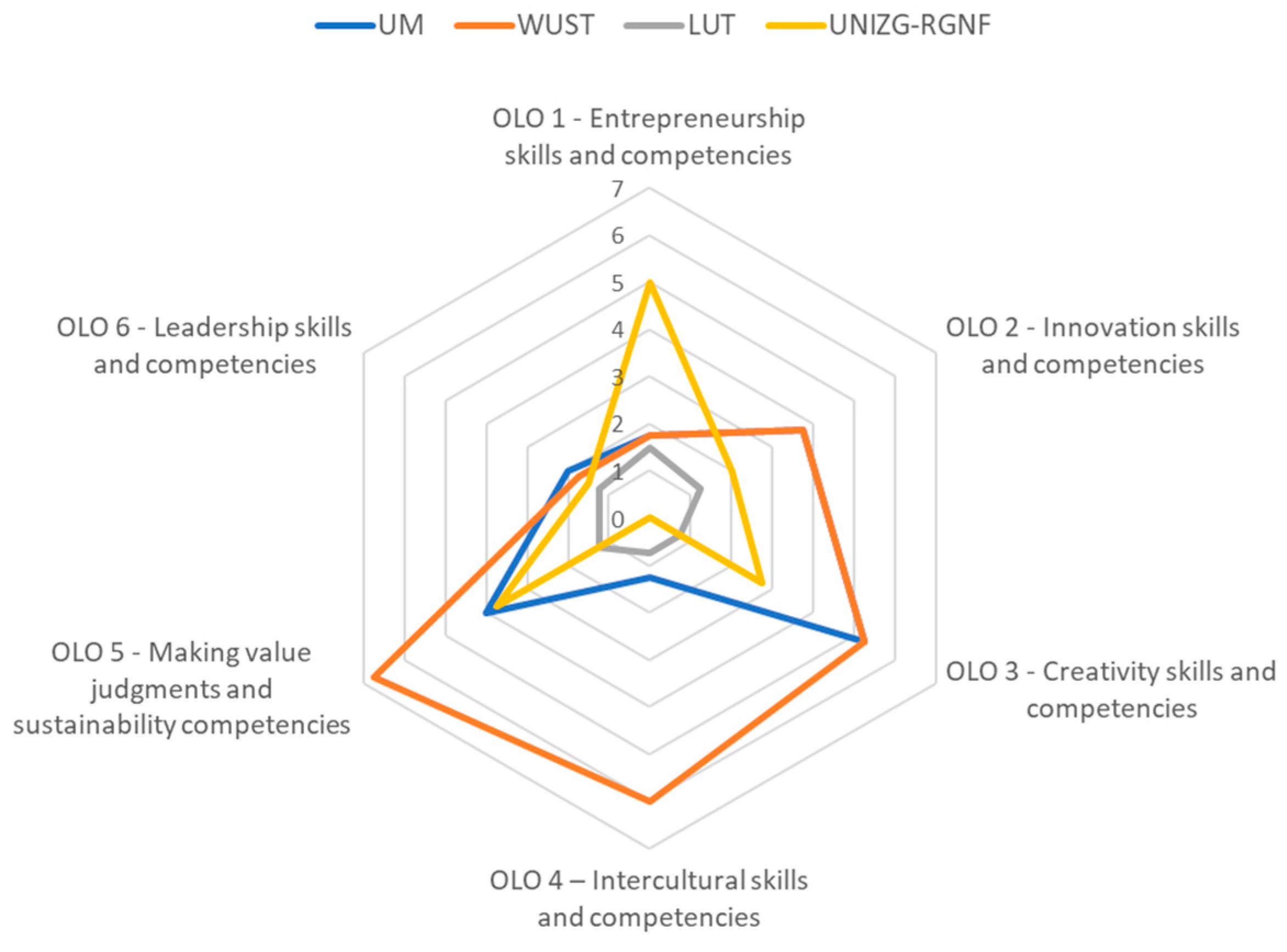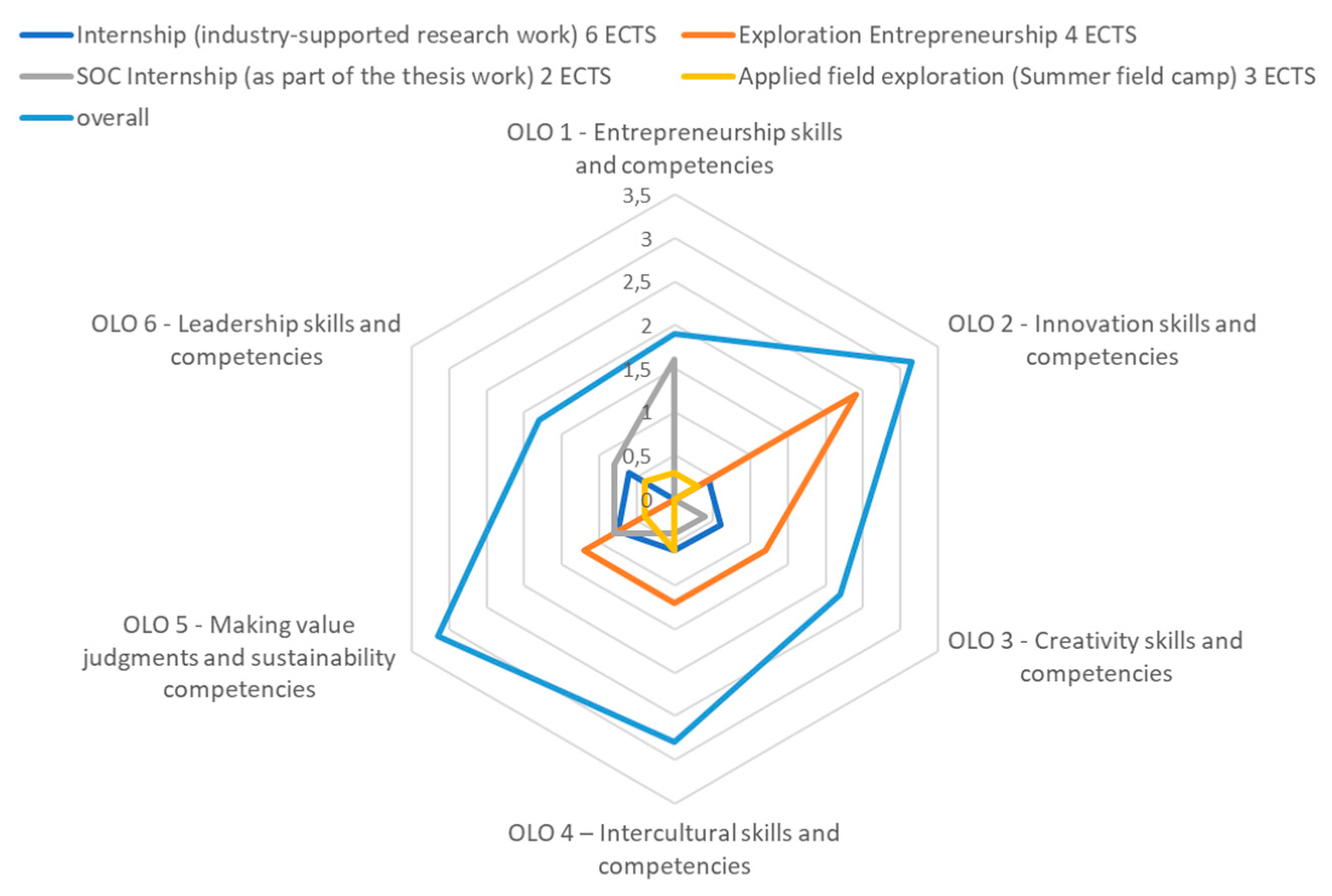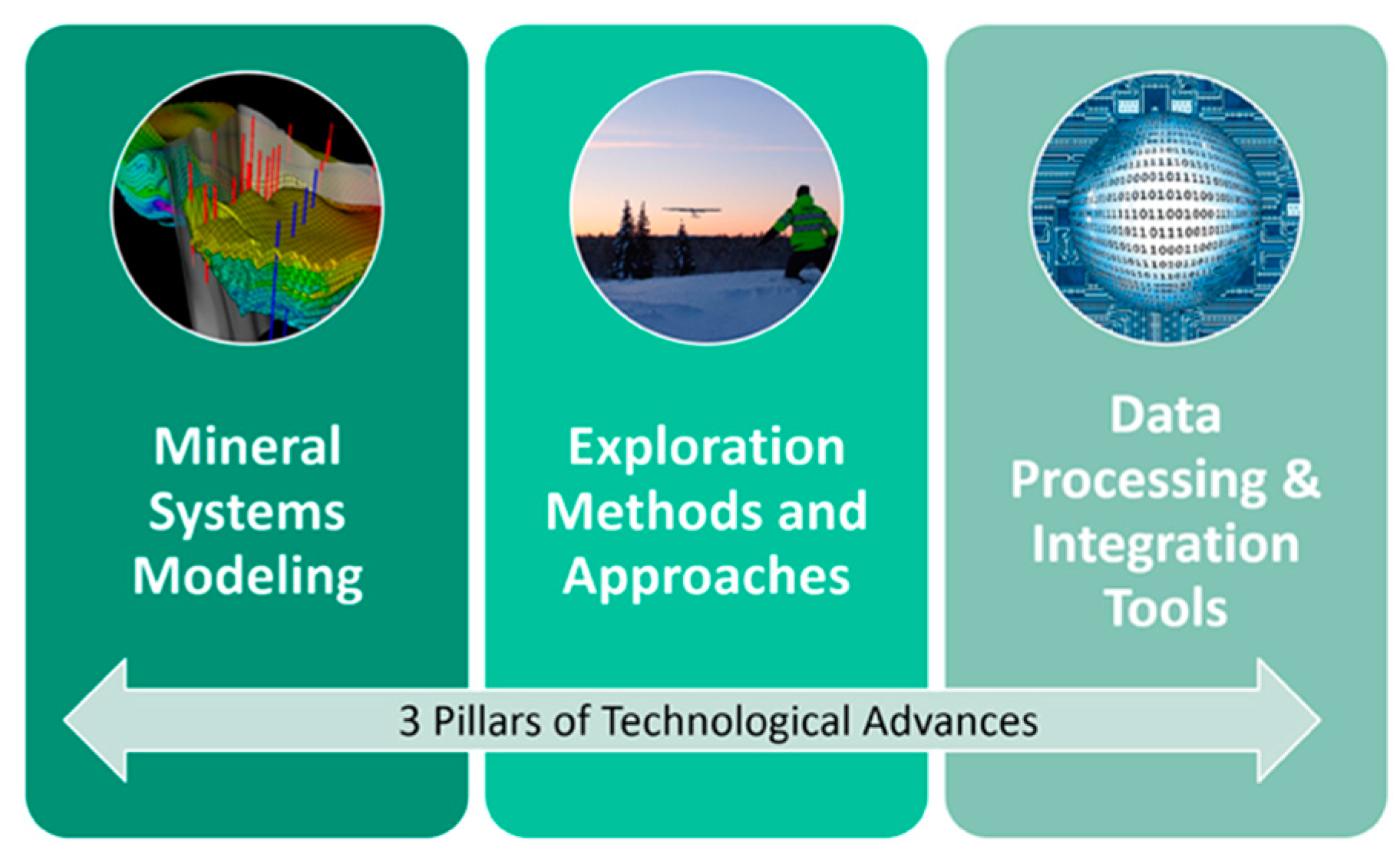Curriculum Development for Improving Mineral Exploration-Related Master Programs towards Innovation, Entrepreneurship and Social Responsibility †
Abstract
:1. Introduction
2. Methodologies
2.1. EIT RawMaterials Questionnaire Campaign
2.2. EIT Overarching Learning Outcomes
3. Results: TIMREX Mineral Exploration Program Curriculum Development
3.1. Embedding Innovation and Entrepreneurship into the Masters Program Curricula
- Direct add-ons to academic courses: solving specific industry problems (innovation and business challenges) via teamwork and interaction with external stakeholders;
- Learning from knowledge triangle stakeholders: industry stakeholder presentations, training courses, seminars, conferences, networking and discussion groups;
- Internships and scholarships: internships with research and industry partners, and participation in field missions;
- Participation in national/international projects, competitions and challenges: entrepreneurial training and the integration of students into international innovation projects;
- Online teaching/learning platforms: dedicated software or platforms for technical and collaborative work, such as Massive Open Online Courses MOOCs.
3.2. Curriculum Development towards Lighthouse Targets
3.3. Field Program Development
3.4. Mentoring Program and Social Responsibility Competencies Development
- (1)
- General: broadening the professional network, improving technical knowledge in a particular field, improving leadership/management skills, acquiring practical tools and strategies for the transition from a junior role into roles with higher responsibilities, benefiting from insider knowledge about work perspectives in another geoscience sector or other countries and obtaining practical advice and contacts, and support for the application to the European geologist title;
- (2)
- Entrepreneurship skills: research and development, risk awareness, business awareness and attitude, market understanding, identifying investment opportunities and knowledge on intellectual property rights.
4. Discussion and Conclusions
- (1)
- The design and launch of a pilot program HEI initiative, Innovation Capacity Building for Higher Education, supporting the innovation and entrepreneurial capacities of HEI. The activities include the exchange and implementation of best practices in knowledge triangle integration, the development of action plans regarding innovation management, start-up creation and development, and technology transfer and its implementation;
- (2)
Author Contributions
Funding
Institutional Review Board Statement
Informed Consent Statement
Data Availability Statement
Conflicts of Interest
References
- EU. Communication from the Commission to the European Parliament, the European Council, the Council, the European Economic and Social Committee and the Committee of the Regions: A Green Deal Industrial Plan for the Net-Zero Age; EU: Brussels, Belgium, 2023; pp. 1–20. [Google Scholar]
- Regueiro, M.; Alonso-Jimenez, A. Minerals in the future of Europe. Miner. Econ. 2021, 34, 209–224. [Google Scholar] [CrossRef]
- Sánchez, F.; Hartlieb, P. Innovation in the Mining Industry: Technological Trends and a Case Study of the Challenges of Disruptive Innovation. Min. Metall. Explor. 2020, 37, 1385–1399. [Google Scholar] [CrossRef]
- “Quality for learning” EIT Quality Assurance and Learning Enhancement Model: EIT Label Handbook for Planning, Labelling and Reviewing Degree Programmes; European Institute of Innovation and Technology (EIT): Budapest, Hungary, 2022; pp. 1–56.
- Oskam, I.F. T-shaped engineers for interdisciplinary innovation: An attractive perspective for young people as well as a must for innovative organisations. In Proceedings of the 37th Annual Conference—Attracting students in Engineering, Rotterdam, The Netherlands, 1–4 July 2009; p. 11. [Google Scholar]
- Gauß, R.; Calleja, I.; Lamm, L.; Nadoll, P.; Zimmermann, D.; Klossek, A.; Schäfer, B. EIT Raw Materials Lighthouses: Responsible Sourcing, Sustainable Materials, Circular Societies Initiation Document for the EIT RawMaterials Partner Interaction and Debate at the Expert Forum 2022. In EIT RawMaterials; EIT: Budapest, Hungary, 2022; pp. 1–25. [Google Scholar]
- Jansson, N.F.; Ranta, J.P.; Berthet, T.; Supojärvi, L. From oil digger to energy transition enabler: The critical role of exploration geosciences education in Europe. Eur. Geol. 2020, 50, 58–62. [Google Scholar]
- Gibson, H.L.; Allen, R.L.; Riverin, G.; Lane, T.E. The VMS model: Advances and application to exploration targeting. Proc. Explor. 2007, 7, 713–730. [Google Scholar]
- Tornos, F.; Peter, J.M.; Allen, R.; Conde, C. Controls on the siting and style of volcanogenic massive sulphide deposits. Ore Geol. Rev. 2015, 68, 142–163. [Google Scholar] [CrossRef]
- Stein, A. Mineral raw materials in Europe—Chances and challenges for domestic production; EFGeoMentoring. 2020. Available online: https://www.google.com/url?sa=t&rct=j&q=&esrc=s&source=web&cd=&ved=2ahUKEwjr8Y3zpOuBAxWRhf0HHcyYAU8QFnoECBQQAQ&url=https%3A%2F%2Feurogeologists.eu%2Fwp-content%2Fuploads%2F2020%2F05%2FEGJ49_lr.pdf&usg=AOvVaw2L2wn4PR_SoHfgp01LumOK&opi=89978449 (accessed on 10 October 2023).
- IN4SOC Toolkit. Available online: https://blogs.upm.es/in4soc/toolkit (accessed on 10 October 2023).
- Davey, T.; Baaken, T.; Galan-Muros, V.; Deery, M. 30 Good Practice Case Studies in University-Business Cooperation (UBC); Science-to-Business Marketing Research Centre, Munster University of Applied Sciences: Munster, Germany, 2011; p. 178. ISBN 978-92-79-23168-1. [Google Scholar]
- Davey, T.; Baaken, T.; Galan-Muros, V.; Deery, M.; Meerman, A. The State of European University Business Cooperation. Part of the DG Education and Culture Study on the Cooperation between Higher Education Institutions and Public and Private Organisations in Europe; Science-to-Business Marketing Research Centre, Munster University of Applied Sciences: Munster, Germany, 2011; p. 140. [Google Scholar]
- State of University-Business Cooperation in Europe. Available online: https://www.ub-cooperation.eu/index/reports (accessed on 10 October 2023).
- Jongbloed, B.; Kottmann, A. Guidelines for using HEInnovate and the Value Proposition Canvas in Entrepreneurial Change Processes in Higher Education Institutions; CHEPS, University of Twente: Enschede, The Netherlands, 2022; pp. 1–15. [Google Scholar]
- ENIHEI Report—Recommendations on Innovation in European Higher Education. Available online: https://education.ec.europa.eu/document/enihei-report-recommendations-on-innovation-in-european-higher-education (accessed on 10 October 2023).
- Decision (EU) 2021/820 of the European parliament and of the council of 20 May 2021 on the Strategic Innovation Agenda of the European Institute of Innovation and Technology (EIT) 2021-2027: Boosting the Innovation Talent and Capacity of Europe and repealing. Decision No 1312/2013/EU. Off. J. Eur. Union L 189 2021, 64, 91–118.
- Adach-Pawelus, K.; Gogolewska, A.; Górniak-Zimroz, J.; Kiełczawa, B.; Krupa-Kurzynowska, J.; Paszkowska, G.; Szyszka, D.; Worsa-Kozak, M.; Woźniak, J. A new face of mining engineer—International curricula to sustainable development and green deal (a case study of the Wrocław University of Science and Technology). Sustainability 2021, 13, 1393. [Google Scholar] [CrossRef]
- Adach-Pawelus, K.; Gogolewska, A.; Górniak-Zimroz, J.; Herrera Herbert, J.; Hidalgo, A.; Kiełczawa, B.; Krupa-Kurzynowska, J.; Lampinen, M.; Mamelkina, M.A.; Paszkowska, G.; et al. Towards sustainable mining in the didactic process-MEITIM project as an opportunity to increase the attractiveness of mining courses (a case study of Poland). Sustainability 2020, 12, 10138. [Google Scholar] [CrossRef]



| Definition (from the EIT Label Handbook [4]) | TIMREX’s Approach |
|---|---|
| Innovation: the ability to formulate knowledge, ideas and technology to create new or significantly improved products, services, processes, policies, new business models or jobs, and to mobilize system innovation to contribute to broader societal change, while evaluating the unintended consequences of innovation and technology. | Within TIMREX classes, innovation elements are included in the teaching methodology, including teaching innovative methodologies and the innovation process. This is complemented by the fieldwork aspect, where students should be able to see, learn and use innovative technologies developed by research and industry partners in a hands-on approach. The mentoring program focuses on supporting the development of knowledge and ideas for innovation creation. |
| Entrepreneurship: the capacity to identify and act upon opportunities and ideas to create social, cultural and financial value for others, including translating innovations into feasible business solutions, with sustainability at their core. | TIMREX makes strong use of fieldwork (in mining areas, supported by industry partners, and visits to research centres) with high levels of technological input from research and industry exploration companies, which show students how innovative prospects can be created to generate value. The business ideation and creation processes of partner companies are used to provide entrepreneurial skills. During the mentoring program, students shall be able to learn how to bring ideas into business creation and will be offered organizational support to kick-start their own ideas. |
Disclaimer/Publisher’s Note: The statements, opinions and data contained in all publications are solely those of the individual author(s) and contributor(s) and not of MDPI and/or the editor(s). MDPI and/or the editor(s) disclaim responsibility for any injury to people or property resulting from any ideas, methods, instructions or products referred to in the content. |
© 2023 by the authors. Licensee MDPI, Basel, Switzerland. This article is an open access article distributed under the terms and conditions of the Creative Commons Attribution (CC BY) license (https://creativecommons.org/licenses/by/4.0/).
Share and Cite
Šoštarić, S.B.; Paszkowska, G.; Jansson, N.; Lopes, L.; Miravalles, A.S.; Maričić, A.; Mádai, F. Curriculum Development for Improving Mineral Exploration-Related Master Programs towards Innovation, Entrepreneurship and Social Responsibility. Mater. Proc. 2023, 15, 8. https://doi.org/10.3390/materproc2023015008
Šoštarić SB, Paszkowska G, Jansson N, Lopes L, Miravalles AS, Maričić A, Mádai F. Curriculum Development for Improving Mineral Exploration-Related Master Programs towards Innovation, Entrepreneurship and Social Responsibility. Materials Proceedings. 2023; 15(1):8. https://doi.org/10.3390/materproc2023015008
Chicago/Turabian StyleŠoštarić, Sibila Borojević, Gabriela Paszkowska, Nils Jansson, Luis Lopes, Alberto Sanchez Miravalles, Ana Maričić, and Ferenc Mádai. 2023. "Curriculum Development for Improving Mineral Exploration-Related Master Programs towards Innovation, Entrepreneurship and Social Responsibility" Materials Proceedings 15, no. 1: 8. https://doi.org/10.3390/materproc2023015008
APA StyleŠoštarić, S. B., Paszkowska, G., Jansson, N., Lopes, L., Miravalles, A. S., Maričić, A., & Mádai, F. (2023). Curriculum Development for Improving Mineral Exploration-Related Master Programs towards Innovation, Entrepreneurship and Social Responsibility. Materials Proceedings, 15(1), 8. https://doi.org/10.3390/materproc2023015008






